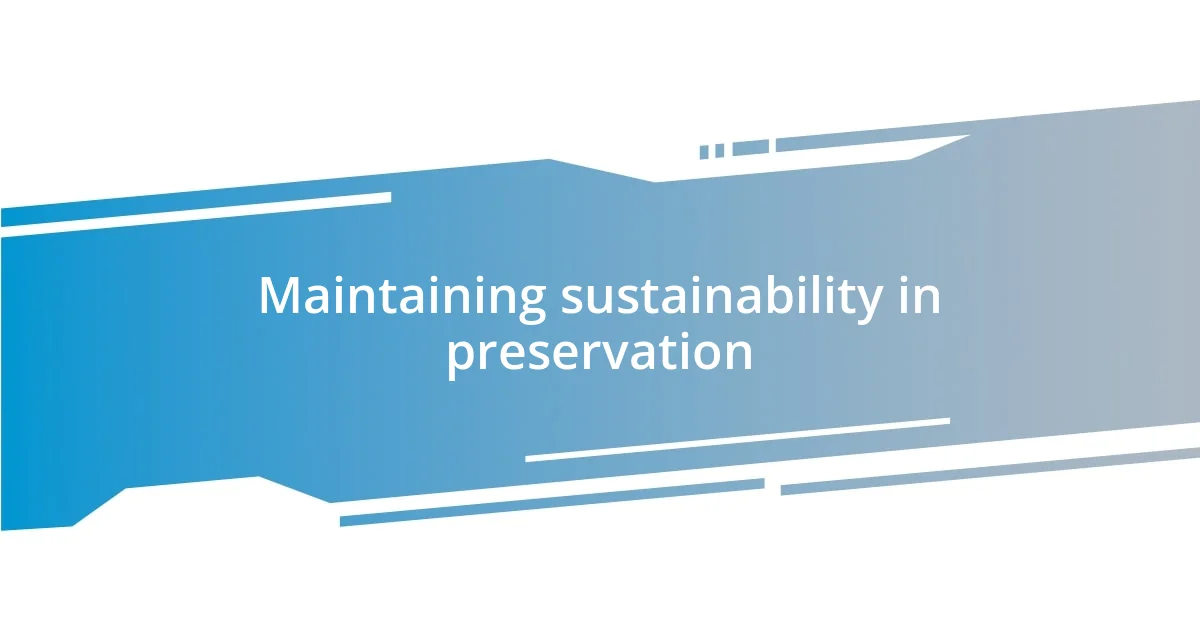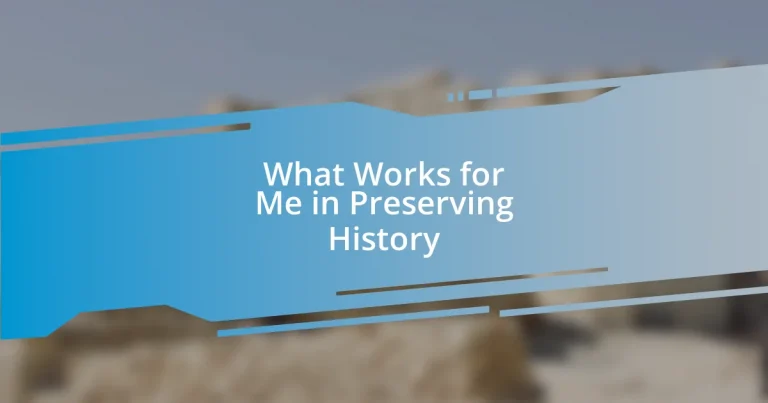Key takeaways:
- Preservation connects us to our past and fosters a sense of identity through artifacts and storytelling.
- Documenting history through oral histories, photography, and written records enriches our understanding of personal and communal narratives.
- Leveraging technology and engaging with the community enhances our ability to share, preserve, and celebrate history sustainably.

Understanding the importance of preservation
Preservation is crucial because it acts as a time capsule, connecting us to our past. I remember visiting an old library in my town, with its faded pages and whispers of stories long forgotten. It struck me then how each book held not just words, but echoes of lives lived and lessons learned.
Thinking about preservation leads me to ask: What stories are we willing to let slip away? Each artifact, whether a photograph or a historic building, tells a narrative that might otherwise be lost. I often reflect on the thrill of uncovering these narratives—it’s like piecing together a jigsaw puzzle of human experience.
Moreover, preservation fosters a sense of identity and belonging. When I walk through preserved neighborhoods, I feel a connection to the people who once walked those same streets. It’s a powerful reminder that history is more than just dates and events; it’s about the people and communities that have shaped our world. Isn’t it inspiring to think that our efforts today can help future generations understand their roots?

Techniques for documenting history
Documenting history is a multifaceted endeavor that can take many forms. One technique I often find myself drawn to is oral history. I’ve had the privilege of sitting down with elders in my community, listening to their tales and experiences. These conversations bring history to life in a way that textbooks simply can’t match. There’s a certain magic in the way their voices convey emotions and nuances that make their stories resonate deeply within me.
Another effective method is photography. I remember exploring an abandoned factory, camera in hand, capturing the remnants of industry long past. Each image tells a story, serving as a visual record of a place—and its people—that might be forgotten. I often think about how an image can evoke feelings and provoke thoughts, becoming a powerful tool for future generations to understand the reality of lives led.
Lastly, written documentation is essential. Journals, letters, and even digital platforms allow us to chronicle events and reflections in a detailed manner. In my own experience, maintaining a history blog has enabled me to share findings and thoughts, creating a dialogue with others who share a passion for the past. Isn’t it fascinating how techniques like these can intertwine to create a rich tapestry of history that we can all appreciate?
| Technique | Description |
|---|---|
| Oral History | Recording personal accounts and stories from individuals to preserve their lived experiences. |
| Photography | Capturing images of artifacts, locations, or events to visually document a moment in time. |
| Written Documentation | Maintaining journals, letters, or digital records to chronicle history in detail. |

Creating a personal archive
Creating a personal archive can be an enriching journey. I began my own archive when I stumbled upon a box of letters written by my grandparents during their courtship. Each letter unraveled layers of their personalities, hopes, and dreams—opening a window into their world that I had never truly understood. It’s heartwarming to realize that these fragments of the past can breathe life into my own history and help me connect more deeply with my family legacy.
To start your own personal archive, consider these helpful steps:
– Collect Artifacts: Gather items like letters, photographs, and memorabilia that tell your family’s story.
– Organize Chronologically: Keep items arranged by date to track the evolution of your family’s journey over time.
– Annotate Each Item: Write notes about the context of each artifact, adding your reflections and stories associated with them.
– Digitize and Backup: Consider scanning important documents and photos for backup, preserving them in multiple formats for safety.
– Share Your Archive: Engage family members by sharing the archive, inviting them to contribute their stories and memories.
By actively engaging with these practices, you can enrich your understanding and appreciation of your family’s history. There’s something profoundly gratifying about taking control of the narrative—like holding a piece of your legacy in your hands.

Leveraging technology in preservation
One of the most exciting aspects of leveraging technology in preservation is the use of digital archiving tools. I recall the first time I scanned old family photos and documents; it felt like breathing new life into memories that were fading away. By organizing them in a cloud-based system, I not only ensured their safety but also made it easy for distant relatives to access and appreciate our shared history. Isn’t it remarkable how something as simple as technology can bridge the gap between generations?
Another method I’ve embraced is the utilization of social media platforms for historical storytelling. Not long ago, I shared a series of posts about my great-grandfather’s immigration journey, pairing his old passport photos with the stories my family told me. The feedback was overwhelming! Friends and distant cousins chimed in, sharing their own experiences and connections. This engagement reminded me how technology fosters a communal approach to keeping history alive. Could there be a better way to not only honor our past but weave it into our present?
Additionally, I find that mobile apps designed for history enthusiasts offer amazing ways to document stories, artifacts, and even experiences. On a recent trip, I used an app to map out significant sites related to my community’s history, complete with notes and photos. It turned a simple outing into an engaging exploration of our roots! Imagine how this fusion of technology and history can inspire curiosity and ignite a passion for preservation in younger generations.

Engaging with the community
Engaging with the community has always been close to my heart. One memorable experience was when I participated in a local history day, where neighbors brought their unique artifacts—each with its own story. As I listened to an elderly gentleman share tales about a 100-year-old photograph of our town square, I felt an instant connection not just to him, but to the very fabric of our community’s history. It made me realize how much we can learn from one another when we come together to celebrate our shared past.
More recently, I attended a workshop focused on oral history collection. It struck me how powerful storytelling can be. I vividly recall a woman sharing her family’s experiences during the civil rights movement. Her voice quivered with emotion, and as she recounted the struggles and triumphs, I felt a palpable sense of pride and responsibility to preserve these narratives. Isn’t it fascinating how these stories, passed down from generation to generation, can unify us and illuminate our understanding of one another?
I often find that organizing community events like history fairs or storytelling nights is not only enjoyable but incredibly rewarding. On one occasion, I hosted a “History Potluck,” where attendees brought a dish and a family story to share. The room buzzed with laughter and nostalgia as we exchanged recipes alongside our histories. It was a beautiful reminder that food, like stories, holds the power to connect our lives—turning strangers into friends. Have you ever considered how communal experiences can deepen our appreciation for the past?

Sharing historical insights online
Sharing historical insights online has been a transformative experience for me. I started a blog to document my family’s history, and it quickly became a hub for discussions around our cultural roots. One post about my grandmother’s recipe for homemade pasta sparked a lively exchange where readers shared their own versions and memories tied to cooking. It was heartwarming to see how a simple dish could connect so many people across different backgrounds. Have you ever felt that rush of nostalgia when someone else shares a slice of their past?
Using platforms like Instagram for visual storytelling has also been eye-opening. I remember posting a photo of a dusty old trunk filled with letters from my great-aunt, reflecting on her life during World War II. The reactions were immediate and emotional, with many followers sharing their own family treasures in the comments. This digital sharing creates a tapestry of collective memory, doesn’t it? It’s fascinating how we can celebrate our histories together, even if physically apart.
Another avenue I’ve found incredibly impactful is online community forums dedicated to history enthusiasts. Recently, I participated in a discussion about WWII memorabilia, where I was able to contribute my insights and learn from others’ experiences, particularly regarding how they preserved precious items. This exchange deepened not only my understanding but also sparked friendships based on shared passions. Can you imagine how this sense of belonging can energize our commitment to preserving history?

Maintaining sustainability in preservation
Maintaining sustainability in preservation is something I take quite seriously. During my last volunteer project at a historical site, we discussed the importance of using eco-friendly materials for restoration. I remember the excitement when we discovered a natural adhesive made from plant resins that was as effective as synthetic options, but much kinder to the environment. Have you ever thought about how our preservation efforts can impact the planet we cherish?
I also find that incorporating local resources into preservation projects fosters both sustainability and community pride. For instance, when we renovated a small town museum, we sourced reclaimed wood from old barns nearby. Not only did this choice give the building character, but it also reclaimed history and showed the community that their stories matter. Isn’t it fascinating how the materials we use can connect us to our roots even as we preserve them?
Moreover, I believe in the power of education to promote sustainable preservation practices. Last summer, I organized a workshop for families on how to care for heirlooms, emphasizing environmentally friendly techniques. Watching participants light up as we discussed simple methods like using vinegar for cleaning was truly rewarding. It made me realize how easily we can shift mindsets about preservation simply by sharing knowledge. Have you ever felt that spark when teaching someone about something you love? It’s that connection that drives us all to preserve history for future generations.












